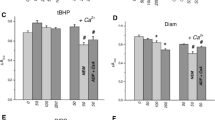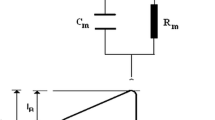Summary
Mechanisms of proton transport were investigated in phospholipid bilayer membranes exposed to salicylates and benzoates. Membranes were formed from diphytanoyl phosphatidylcholine in decane plus chlorodecane (50% vol/vol). Proton and anion conductances (G H andG A) were calculated from the total conductances and the H+ or A diffusion potentials produced by transmembrane H+ or A gradients. At low pH salicylate caused aG H which was proportional to the square of the total weak acid concentration, andG H was maximum when pH=pK. At neutral to alkaline pH salicylate caused aG A which was proportional to the first power of the salicylate concentration, andG A was independent of pH. BothG H andG A were inhibited by phloretin. The results suggest that salicylate acts as an HA2-type proton carrier at low pH and as a lipid-soluble anion at neutral pH. Salicylate has been implicated as a causal factor in Reye's syndrome, as well as in aspirin poisoning, and salicylate has been reported to increase the proton conductance of inner mitochondrial membranes. The present results suggest that in mitochondria salicylate increases passive proton uptake by a combination of HA influx (driven by the concentration gradient) and A efflux (driven by the voltage and concentration gradients). Model calculations suggest that over the range of therapeutic to toxic concentrations, salicylate causes net H+ influx sufficient to explain the reported “loose coupling,” uncoupling and swelling of mitochondria. the relative ineffectiveness of aspirin and benzoate can be explained by their low A permeabilities, whereas the ineffectiveness of 2,6-dihydroxybenzoate can be explained by its low pK.
Similar content being viewed by others
References
Andersen, O.S., Finkelstein, A., Katz, I., Cass, A. 1976. Effect of phloretin on the permeability of thin lipid membranes.J. Gen. Physiol. 67:749–771
Aprille, J.R. 1977. Reye's syndrome: Patient serum alters mitochondrial function and morphology in vitro.Science 197:908–910
Benz, R., McLaughlin, S. 1983. The molecular mechanism of action of the proton ionophore FCCP (carbonylcyanidep-trifluoromethoxy-phenylhydrazone).Biophys. J. 41:381–398
Brody, T.M. 1956. Action of sodium salicylate and related compounds on tissue metabolism in vitro.J. Pharmacol. 117:39–51
Crandall, E.D., Winter, H.I., Schaeffer, J.D., Bidani, A. 1982. Effects of salicylate on HCO −3 /Cl− exchange across the human erythrocyte membrane.J. Membrane Biol. 65:139–145
Cunarro, J., Weiner, M.W. 1975. Mechanism of action of agents which uncouple oxidative phosphorylation: Direct correlation between proton-carrying and respiratory-releasing properties using rat liver mitochondria.Biochim. Biophys. Acta 387:234–240
Dilger, J.P., McLaughlin, J.G.A., McIntosh, T.J., Simon, S.A. 1979. The dielectric constant of phospholipid bilayers and the permeability of membranes to ions.Science 206:1196–1198
Finkelstein, A. 1970. Weak-acid uncouplers of oxidative phosphorylation. Mechanism of action on thin lipid membranes.Biochim. Biophys. Acta 205:1–6
Flower, R.J., Moncada, S., Vane, J.R. 1985. Analgesic-antipyretics and anti-inflammatory agents.In: The Pharmacological Basis of Therapeutics. (7th Ed.) A.G. Gillman, L.S. Goodman, T.W. Rall, and F. Murad, editors. pp. 674–715. Macmillan, New York
Forsyth, B.W., Horwitz, R.I., Acampora, D., Shapiro, E.D., Viscoli, C.M., Feinstein, A.R., Henner, R., Holabird, N.B., Jones, B.A., Karabelas, A.D.E., Kramer, M.S., Miclette, M., Wells, J.A. 1989. New epidemiologic evidence confirming that bias does not explain the aspirin/Reye's syndrome association.JAMA 261:2517–2524
Gutknecht, J. 1987. Proton conductance through phospholipid bilayers: Water wires or weak acids?J. Bioenerg. Biomembr. 19:427–442
Gutknecht, J. 1987. Proton/hydroxide conductance through phospholipid bilayer membranes: Effects of phytanic acid.Biochim. Biophys. Acta 898:97–108
Gutknecht, J. 1988. Proton conductance caused by longchain fatty acids in phospholipid bilayer membranes.J. Membrane Biol. 106:83–93
Gutknecht, J. 1989. Proton transport caused by salicylates in phospholipid bilayer membranes: A model for salicylate-induced “loose coupling” in mitochondria.Biophys. J. 55:568a
Gutknecht, J., Tosteson, D.C. 1973. Diffusion of weak acids through lipid bilayer membranes: Effects of chemical reactions in the aqueous unstirred layers.Science 182:1258–1261
Haas, R., Parker, W.D., Stumpf, D., Eguren, L.A. 1985. Salicylate-induced loose coupling: Protonmotive force measurements.Biochem. Pharmacol. 34:900–902
Hall, J.E., Mead, C.A., Szabo, G. 1973. A barrier model for current flow in lipid bilayer membranes.J. Membrane Biol. 11:75–97
Hladky, S.B. 1974. The energy barriers to ion transport by nonactin across thin lipid membranes.Biochim. Biophys. Acta 352:71–85
Joy, M.M., Cutler, D.J. 1987. On the mechanism of transport of salicylate andp-hydroxybenzoic acid across human red cell membranes.J. Pharm. Pharmacol. 39:266–271
Kasianowicz, J., Benz, R., McLaughlin, S. 1984. The kinetic mechanism by which CCCP (carbonylcyanidem-chlorophenylhydrazone) transports protons across membranes.J. Membrane Biol. 82:179–190
Kauffman, G. 1989. Aspirin-induced gastric mucosal injury: Lessons learned from animal models.Gastroenterology 96:606–614
Lea, E.J.A., Croghan, P.C. 1969. The effect of 2,4-dinitrophenol on the properties of thin lipid films.J. Membrane Biol. 1:225–237
Leo, A., Hansch, C., Elkins, D. 1971. Partition coefficients and their uses.Chem. Rev. 71:525–616
McLaughlin, S. 1972. The mechanism of action of DNP on phospholipid bilayer membranes.J. Membrane Biol. 9:361–371
McLaughlin, S. 1973. Salicylates and phospholipid bilayer membranes.Nature (London) 243:234–236
McLaughlin, S.G.A., Dilger, J.P. 1980. Transport of protons across membranes by weak acids.Physiol. Rev. 60:825–863
Mitchell, P., Moyle, J. 1967. Acid-base titration across the membrane system of rat-liver mitochondria.Biochem. J. 104:588–600
Nicholls, D.G. 1982. Bioenergetics: An Introduction to Chemiosmotic Theory. Academic, New York
Pauling, L. 1960. The Nature of the Chemical Bond. (3rd Ed.) Cornell University Press, Ithaca, New York
Perkins, W., Cafiso, D.S. 1987. Procedure using voltage-sensitive spin-labels to monitor dipole potential changes in phospholipid vesicles: The estimation of phloretin-induced conductance changes in vesicles.J. Membrane Biol. 96:165–173
Pinsky, P.F., Hurwitz, E.S., Schonberger, L.B., Gunn, W.J. 1988. Reye's syndrome and aspirin: Evidence for a doseresponse effect.JAMA 260:657–661
Rainsford, K.D. 1984. Aspirin and the Salicylates. Butterworths, New York
Scarpa, A. 1978. Transport across mitochondrial membranes.In: Membrane Transport in Biology. G. Giebisch, D.C., Tosteson, and H.H. Ussing, editors. Vol. 2, pp. 263–355. Springer-Verlag, New York
Serjeant, E.P., Dempsey, B. 1979. Ionisation Constants of Organic Acids in Aqueous Solution. Pergamon, New York
Stumpf, D.A. 1979. Mitochondrial multisystem disorders: Clinical, biochemical and morphologic features.In: Current Neurology. H.R. Tyler and D.M. Dawson, editors. Vol. 2, pp. 117–149. Mifflin Professional Publishers, Boston
Szabo, G., Eisenman, G., McLaughlin, S.G.A., Krasne, S. 1972. Ionic probes of membrane structures.Ann. NY Acad. Sci. 195:273–290
Vane, J., Botting, R. 1987. Inflammation and the mechanism of action of anti-inflammatory drugs.FASEB J. 1:89–96
Walter, A., Gutknecht, J. 1984. Monocarboyxlic acid permeation through lipid bilayer membranes.J. Membrane Biol. 77:255–264
Whitehouse, M.W. 1964. Biochemical properties of anti-inflammatory drugs: III. Uncoupling of oxidative phosphorylation in a connective tissue (cartilage) and liver mitochondria by salicylate analogues.Biochem. Pharmacol. 13:319–336
You, K. 1983. Salicylate and mitochondrial injury in Reye's syndrome.Science 221:163–165
Author information
Authors and Affiliations
Rights and permissions
About this article
Cite this article
Gutknecht, J. Salicylates and proton transport through lipid bilayer membranes: A model for salicylate-induced uncoupling and swelling in mitochondria. J. Membrain Biol. 115, 253–260 (1990). https://doi.org/10.1007/BF01868640
Received:
Revised:
Issue Date:
DOI: https://doi.org/10.1007/BF01868640




